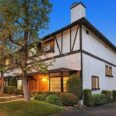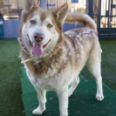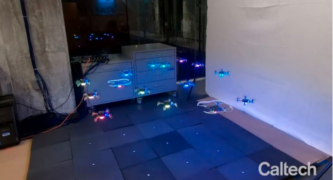
A group of researchers at Caltech have unveiled a new system they’ve developed to allow a virtually unlimited number of robots to work together in cluttered, unmapped spaces without colliding with one another, the university announced this week.
As a demonstration, the team flew a “swarm” of 16 drones together in a tight space, showing how each one was able to consider its surroundings and avoid collisions.
The system was developed by Bren Professor of Aerospace Soon-Jo Chung; Professor of Computing and Mathematical Sciences Yisong Yue; graduate student Benjamin Rivière; postdoctoral scholar Wolfgang Hönig; and graduate student Guanya Shi, according to Caltech.
It’s composed of two parts. One is a multi-robot motion-tracking algorithm created by two parts called Global-to-Local Safe Autonomy Synthesis, or GLAS, Caltech said in a written statement. The other is a “swarm-tracking controller augmented to learn complex aerodynamic interactions in close-proximity flight” known as Neural-Swarm.
Scientists have long worked on the challenge of getting large numbers of machines to work together in harmony. But the technical challenges are many, and only increase in complexity with the number of machines making up a group.
“When GLAS and Neural-Swarm are used, a robot does not require a complete and comprehensive picture of the environment that it is moving through, or of the path its fellow robots intend to take,” according to the Caltech statement. “Instead, robots learn how to navigate through a space on the fly, and incorporate new information as they go into a ‘learned model’ for movement.”
Computing can be decentralized, as each robot only needs information about its own local surroundings, rather than those of the entire group.
“In essence, each robot ‘thinks’ for itself, which makes it easier to scale up the size of the swarm,” the statement said.
To test the systems, the teams used the technology to control a fleet of 16 small quadcopters.
“The teams found that GLAS could outperform the current state-of-the-art multi-robot motion-planning algorithm by 20 percent in a wide range of cases,” the Caltech statement said. “Meanwhile, Neural-Swarm significantly outperformed a commercial controller that cannot consider aerodynamic interactions; tracking errors, a key metric in how the drones orient themselves and track desired positions in three-dimensional space, were up to four times smaller when the new controller was used.”
The endeavor has shown some interesting and exciting results, the professors said.
“These projects demonstrate the potential of integrating modern machine-learning methods into multi-agent planning and control, and also reveal exciting new directions for machine-learning research,” Yue said.
“Our work shows some promising results to overcome the safety, robustness, and scalability issues of conventional black-box artificial intelligence (AI) approaches for swarm motion planning with GLAS and close-proximity control for multiple drones using Neural-Swarm,” Chung added.
The researchers’ work recently appeared in the IEEE Robotics and Automation Letters on May 11, as well as Proceedings of IEEE International Conference on Robotics and Automation on June 1.














 0 comments
0 comments


